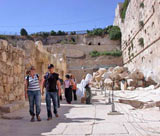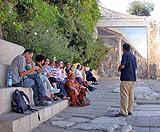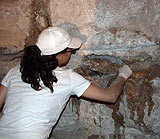|
|
 |
Conservation Workshops and Courses
Between Interpretation and Presentation with the Emphasis on Archaeology
Yael Alef
 |
|
A fieldtrip to the archaeological park in Jerusalem (photograph: Yael Alef)
|
In the summer of 2006 a three day workshop was convened for students of the Program for Certification in Conservation Studies in the Tel Aviv University. The workshop took place in the Rockefeller Museum and at sites in Jerusalem. The primary aim of the workshop was to impart to the students professional knowledge about conservation and to strengthen the cooperation between the Conservation Department of the Antiquities Authority and academia.
The teaching goals included: familiarity with conservation principals guided by interpretation and presentation, for example: when is it possible to reconstruct and complete an artifact and when is it preferable to be content with just stabilization; familiarity with conservation means for interpretation and presentation of the cultural heritage, for example: the different kinds of integration in the conservation and presentation of artifacts, mosaics and buildings, and the differences between them; knowing the role of the conservator and his place on the team alongside the planner and the curator during the interpretation and presentation process. The participants of the workshop were also introduced to a variety of conservation fields, among them artifact conservation, conservation of architectural elements, buildings and sites and the aspects which are related to interpretation and presentation of each of them.
|
 |
|
The visit to the Davidson Center guided by Yuval Baruch, Jerusalem district archaeologist (photograph: Yael Alef)
|
The workshop dealt with various facets of conservation, interpretation and presentation of the cultural heritage and a critical analysis of them. The discussion focused on such questions as: what did the planners choose to tell and to emphasize? What was chosen to be covered over? How is the story conveyed? And how do they cope with the implicit conflict of conservation and presentation whereby the exposure of the finds unavoidably entails their weathering and destruction? The principal concept according to which the workshop was conducted assumes that in order to preserve most of the heritage values, those that are involved in conservation and presentation must carry out a controlled planning and implementation process that is based on conservation ethics as expressed by international conventions. The management of the conservation process actually deals with “conflict management”, an attempt to balance the different needs and approaches of all those involved in the process.
The Workshop Itinerary
The first day of the workshop took place in the Rockefeller Museum, during which questions were posed regarding conservation, interpretation and presentation. The museum itself, as a historic building and as an archaeological museum, stood at the center of the discussion. Over the course of the day lectures were given and the participants toured the museum and the mosaic workshop.
The second day dealt with the conservation, interpretation and presentation of artifacts. During the course of it the students were shown the laboratories for the conservation of pottery, glass and metal in the Artifacts Treatment Department of the Antiquities Authority. Afterwards the students visited the conservation laboratories for the Dead Sea scrolls followed by a guided tour of the Shrine of the Book under the direction of its curator Dr. Adolfo Roitman.
|
 |
|
Experiencing conservation in the Western Wall tunnels (photograph: Yael Alef)
|
The third day focused on an analysis and comparison of the different approaches to conservation and presentation at the assorted sites in the Western Wall compound: the “Chain of the Generations” experience, the Western Wall tunnels, Davidson Center and the archaeological park. In addition to the lectures and the trips to the sites we also experienced practical conservation under the guidance of Yevgeny Ivanovski – Director of the Conservation Project in the Western Wall Tunnels.
Participating in the workshop were archaeologists, conservators and curators, each of which presented the topics from his own different point of view. Thus a diverse picture was presented and a broad foundation was set for an in-depth discussion of questions regarding the conservation, the interpretation and the presentation of heritage. The combination of different professional people, the subjects and the sites, the theoretical information, the fieldtrips, exercises and practical experience were the key to effective learning and the success of the workshop.
“As far as I am concerned the workshop was excellent in the human parameters that cannot be measured: 1) I enjoyed myself; 2) I experienced things not just from the conceptual/intellectual facet but rather primarily from the emotional and sensory side and these are the things that a person takes with him his entire life. Thank you for the seriousness of the organization and the investment you made in us” (Rahel Nahumi, a workshop participant).
|
|
|
|
|


